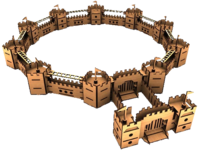Wartbed:Design
From Dark Omen Wiki
Contents |
War And Regimental Tactics Battle Engine Deluxe (WARTBED) High-Level Design Document
This document outlines the large-scale principles and design underlying the WARTBED tactical battles meta-engine.
| ⇐ | WARTBED: Building Blocks for Medieval Tactical Warfare Games |
Overview
|
For a general overview, see the WARTBED Design Document For in-depth view of specific topics and aspects, see |
At its highest level and end goal WARTBED is a meta-engine for tactical wargaming. More precisely, though, WARTBED is a framework to automate a number of tasks related to this:
- 3D graphic of contemporary standards (implemented through the OGRE middleware)
- Input bindings and input handling (where raw input hardware is accessed through the OIS middleware)
- Flexible camera handling suitable for a wide spectrum of strategy game styles
- A GUI system (currently implemented through the CEGUI middleware)
- Human-readable data file parsing
- Audio layer (as of yet unimplemented)
- Scripting language support (as of yet unimplemented)
- Network support (not yet implemented)
Remaining design decisions
- How game modules (Bright Portents etc) should be implemented:
- First option: As internal parts of WARTBED framework itself.
- Second option: Modules are stand-alone applications using WARTBED as a library modules will use.
- Third option: Modules will be fully implemented in script languages using the WARTBED framework.
"Regimental tactical warfare"
What being a framework for implementing tactical regimental warfare games more specifically means is providing a number of standard formats (and data converter to these formats):
- A unit and regiment ability and statistics set capable of accurately represent most games, periods and battle types.
- A regiment representation system capable of handling several individual units organised into formations (which can consist of other regiments), and formatted movement (manoeuvres) of these.
- Battle arena (battlefield) description
- Campaign definition and flow handling
- Unit and regiment ordering system
- Suitable and flexible AI
Design principles
WARTBED is being designed according to a set of principles and assumptions.
| 1. | WARTBED is multi-platform and should be natively compilable on at least Win32, Linux and OSX. |
| 2. | External dependencies are to be kept to a minimum
|
| 3. | The system is divided into a Model-View-Controller design layout to decouple dependencies.
|
| 4. | The structural composition is indented to be as simple as possible. This does not mean that is must be simple, only that it shouldn't be over-complicated or over-designed, which is a common source of failure. Too great complexity means unmaintainable code, while too simple code is limiting, restrictive and incapable of representing a complex game. |
| 5. | WARTBED is written in ANSI C++ without proprietary extensions (f.i. MSVC++ extensions). STL containers are preferred for storage and data management throughout, unless for very specific reasons. |
| 6. | WARTBED is intended to be data-driven to as far en extent as possible.
|
Dependencies
External and third party dependencies are being avoided. Nonetheless, some aspects of a modern game system are impractical or impossible to produce in-house. For such, open-source, free-licensed (Free or LGPL, but not GLP), well tested, stable and actively maintained solutions are acceptable.
- be multi-platform for at least Windows, Linux and OSX
- be fully stand-alone (atomically portable and not introduce additional dependencies)
- be mature and stable
- Be under a liberal, non-viral FOSS licence (f.i. LGPL, MIT, zlib)
| Purpose | Package | Version | Notes |
| 3D Graphics: | OGRE 3D | 1.6 ("Shoggoth") | |
| Input: | OIS (Open Input System) | 1.7 | |
| In-game GUI: | CEGUI | 0.7.1 | See GUI evaluation and GUI widgets |
| Networking: | Boost::ASIO | 1.45 | See Boost::ASIO |
| General-purpose: | Boost | 1.45 | See Boost |
Libraries considered for WARTBED:
- Currently full-scale physics support isn't needed. The physics required consists of gravity, wind and trajectories, which can be sufficiently simulated in native code (air/liquid pressure variance, medium drag etc is unnecessary, and still there is no reason for ragdoll animation or forward kinematics). Candidates would be the Newton framework, ODE (Open Dynamics Engine) or Bullet (preferred due to licencing), all have existing OGRE integration modules.
- For memory management nedmalloc is being evaluated. It is used internally in OGRE and is highly speed- and anti-fragmentation efficient under random usage.
- For audio libraries being avaluated, see Audio evaluation.
- For networking, Boost::ASIO is currently being used.
- Boost is included in WARTBED, but sparingly because of certain overheads. Beyond ASIO, possibly the Boost filesystem may be used.
- Though there is no immediate need for scripting as of yet, alternatives are being evaluated: see Scripting evaluation.
Strictness of MVC organisation
WARTBED strictly separates the game rules and logic (the model) from the session and player management (the controller) and the visual and auditory representation of the game universe (the view). This is emphasises by the client/server architecture used where even local games are clients that connects to a local server, where the clients are strict views removed from any direct model access, and the server is the controller dispatching all communications between player input and underlying game data.
Strictly speaking, WARTBED employs a two-tier controller architecture, where client is a controller with a view module and the server is a controller with a model module, wherefore the two controllers communicate.
Coding standard
Though not religious on the topic WARTBED is coded according to a set code style which is an adaptation of the Allman style.
Strict client/server game architecture
{placeholder text ...}
WARTBED intended to be strictly client server to the extent that even single player games entail the game being a front-end to a local server.
Pros:
- item
Cons:
- Item
{...placeholder text}
Graphics specification
- Further information: Wartbed:Design/Map_format
- The base measurement unit is 1 meter. All 3D graphics are designed with 1 unit == 1 meter.


